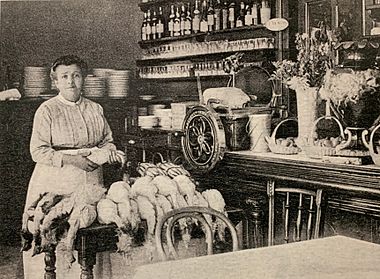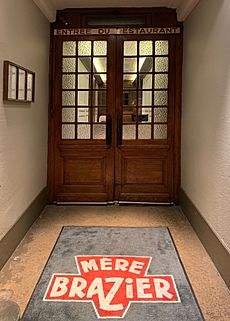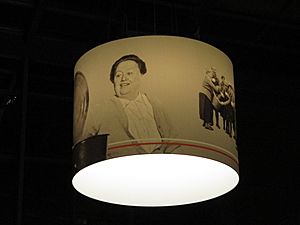Eugénie Brazier facts for kids

"La Mère Brazier"
|
|
| Born | 12 June 1895 La Tranclière, Ain, France |
|---|---|
| Died | 2 March 1977 (aged 81) Sainte-Foy-lès-Lyon, France |
| Cooking style | Lyonnaise cuisine |
|
Rating(s)
|
|
|
Current restaurant(s)
|
|
Eugénie Brazier (born June 12, 1895 – died March 2, 1977) was a famous French chef. People knew her as "la Mère Brazier." In 1933, she made history by becoming the first person to earn six Michelin stars. She received three stars for her restaurant in Lyon, and another three for a second restaurant outside the city. This amazing achievement was not matched by anyone else until Alain Ducasse in 1998.
Eugénie Brazier grew up on a small farm in La Tranclière, near Lyon, France. She started working as a maid when she was a teenager. There, she learned to cook for the families she worked for. Later, she became a junior cook at a top restaurant in Lyon. In 1921, she opened her own restaurant. It quickly became famous across France. She then opened a second restaurant in a chalet outside Lyon.
Brazier followed the cooking traditions of Lyon's famous female chefs, known as the Mères lyonnaises. She focused on simple, high-quality food instead of fancy dishes. She taught many future chefs, including famous ones like Paul Bocuse. Even today, scholarships and awards are given in her name to celebrate her cooking. She was offered France's highest award, the Légion d'honneur, but she said no. Her first restaurant in Lyon is still open today, keeping her classic dishes on the menu.
Eugénie Brazier: A French Cooking Legend
Early Life and Learning to Cook
Eugénie Brazier was born on June 12, 1895. Her birthplace was La Tranclière, a small village in France. Her family had a small farm. She moved to a bigger farm at Certines when she was a baby. Eugénie learned to cook from a very young age. By age five, she knew how to make sweet and savory tarts. One of her first dishes was barbaton, made with fried bacon, onion, potatoes, and garlic.
Her schooling was mostly in winter. She worked on the farm the rest of the year. When she was ten, her mother passed away. This made her chances for school even less. She could read well but never felt confident writing. She continued working on farms through her teenage years.
In 1914, at age 19, Eugénie had a son named Gaston. Having a child without being married was very difficult back then. She then started working as a maid in Lyon for a wealthy family. In 1915, she began cooking for them. She learned by doing, without recipe books. She found that cooking was not complicated. She said, "Cooking is not complicated: you have to be well organised, to remember things and have a bit of taste."
Becoming a Chef in Lyon
After a few years, Brazier started working for a top restaurateur in Lyon. This was Françoise Fillioux, who ran a kitchen with only women. La Mère Fillioux was a tough boss. But under her, Brazier learned many famous dishes. These included quenelles au gratin with crayfish butter. She also learned artichoke hearts with truffled foie gras.
Her most important lesson was the house specialty: volaille truffée demi-deuil. This was a Bresse chicken poached in chicken stock. Slices of black truffle were placed under its skin. When cooked, the truffle showed through the white skin. This made the chicken look black and white, like "half-mourning." She also learned to cook different types of game.
After working for Fillioux, Brazier moved to another restaurant. It was called the Brasserie du Dragon. She earned more money there. She stayed until 1921. In April of that year, at 26 years old, she was ready to open her own place.
Opening Her First Restaurant
Brazier bought an empty shop at 12 rue Royale in Lyon. She did not have much money, only 12,000 francs. But with help from friends and suppliers, she built her business. She started to get many regular customers. Her partner, Pierre, helped her in the evenings. He cleaned, sharpened knives, and prepared wine.
At first, her restaurant could only fit 15 people. But Eugénie slowly made it bigger. She added a second dining room and private rooms upstairs.
In 1925, La Mère Fillioux died. Brazier was then seen as the new top chef in Lyon. She became famous outside Lyon after a car company director ate at her restaurant. He was so impressed that he asked her to cook for his company's car rally. The event was a big success. She was then invited to Paris every year to cook for 200 people. She served her famous quenelles and the "half-mourning" chicken. By the late 1920s, other chefs were trying to copy her dishes.
Brazier was very strict about the quality of her ingredients. Her chicken supplier joked that she would soon ask for manicures for the birds. She also kept her kitchen very clean. She hated waste and would use food trimmings for staff meals. Anything left by diners went to feed her pigs. Her menu changed with the seasons. She was a strong woman with a loud voice and direct language. She sometimes told regular customers what they would eat.
Earning Michelin Stars
By the late 1920s, Brazier was tired from working so hard. She left her son, Gaston, in charge of the Lyon restaurant. She moved to an old wooden chalet at Col de la Luère. This was 17 kilometers (10.5 miles) from Lyon, high above the city. As she felt better, she started making light lunches for old customers who visited her. Slowly, she built a second restaurant there. The Restaurant Mère Brazier at Col de la Luère became a country version of her Lyon restaurant.
The food writer Elizabeth David described this restaurant as airy and cool. It had a large garden and lots of greenery. The menu rarely changed. The food was simple but excellent. David felt a sense of calm confidence there. She said the cooking was the best and most traditional French provincial cooking.
In 1932, Brazier earned two stars from the Michelin Guide for each of her two restaurants. The next year, 1933, the guide started giving three-star ratings. Brazier became the first chef to get six stars. Both her restaurants received three stars. No other chef achieved this for 64 years!
Challenges and Lasting Influence
Cooking During Wartime
One of Brazier's famous customers was Édouard Herriot, the mayor of Lyon. He said she did more than he did to make the city famous. During World War II, Herriot was imprisoned. Brazier faced problems with the authorities. She refused to lower her cooking standards. She was fined many times and even jailed for a week. This was for breaking the rules about food rationing set by the Nazis. In 1941, her Lyon restaurant was ordered to close for buying food without permission.
Training Future Chefs
When the war ended, Brazier held a big party at her Col de la Luère restaurant. She hired a band and a clown. Her guests sang La Marseillaise. Both her restaurants became famous again. From 1946, Brazier let her son Gaston manage the Lyon restaurant. He, his wife, and later their daughter continued her traditions. Brazier focused on the Col de la Luère.
Many young chefs learned from her there. Two of the most famous were Paul Bocuse and Bernard Pacaud. They both wrote tributes to her in her recipe book. Brazier's niece's husband, Roger Garnier, was her second-in-command for 20 years. Every February, Brazier and the Garniers visited other top restaurants in France to get new ideas.
The Michelin ratings for the Col de la Luère restaurant changed over time. It lost a star in 1960. Brazier took over the kitchen again, and the three stars were restored in 1963. The third star was removed again in 1968, when Brazier retired.
In 1968, at age 72, Brazier gave her restaurants to Gaston. In 1971, his daughter, Jacotte Brazier, joined the Lyon restaurant. She took over after Gaston died in 1974. Eugénie Brazier was offered the Légion d'honneur, France's highest award. But she turned it down. She said it should be for more important things than just cooking well.
Eugénie Brazier died on March 2, 1977, at 81 years old. The Col de la Luère restaurant closed. But the Lyon restaurant continued under Jacotte until 2004. In 2008, chef Mathieu Viannay bought the restaurant. He kept its name and 1930s style. He also kept Brazier's classic dishes, like the volaille demi-deuil, on the menu.

What Was Her Food Like?
Eugénie Brazier was known for menus that didn't change much. But her recipe book, published after she died, has over 300 dishes. It shows her wide range of cooking. Starters included artichokes with foie gras and grilled boudin. Main courses featured her famous chicken demi-deuil. Other dishes were roast pork, chicken with morels and cream, and fillet steak. Desserts included ice cream bombe with fresh pineapple and peaches flambéed with Kirsch.
Elizabeth David described Brazier's food as "sumptuous simplicity." It was lighthearted and perfect. She remembered a salad of artichoke hearts and walnuts. Desserts included fromage frais with fresh cream and a thin apple tart. The vanilla ice cream was also beautiful.
How Eugénie Brazier is Remembered
Many famous people ate at Brazier's restaurants. These included Marlene Dietrich and Charles de Gaulle. For the food writer Curnonsky, Brazier was the best chef in the world. Some say her cooking was the start of modern French cooking. Paul Bocuse called her "one of the pillars of global gastronomy." When she died, newspapers in France and other countries wrote about her.
However, outside France, many people forgot about Brazier's achievements for a long time. When Alain Ducasse got his sixth Michelin star in 1998, some thought he was the first chef to do so. In 2016, an article asked, "How history erased this influential chef." It noted that many books about great chefs didn't mention her.
Her Legacy Today

In France, Eugénie Brazier was not forgotten. Her recipe book was published in 1977 and had new editions in 1992 and 2001. In 2003, a street near her restaurant in Lyon was renamed rue Eugénie-Brazier.
In 2007, her granddaughter Jacotte started an association. It is called l'association des Amis d'Eugénie Brazier (Friends of Eugenie Brazier). Its goal is to help young women chefs. It guides and supports them in the "very masculine world of cooking." The association helps young women with tuition fees and training materials. It also gives out annual Eugénie Brazier Literary Prizes. These awards are for cookbooks and food-related writing.
Brazier was honored with a Google Doodle on June 12, 2018. This was on her 123rd birthday. A 2019 documentary about female chefs, The Heat: A Kitchen (R)evolution, also featured Brazier. It showed her as a key figure for today's female chefs.
Books by Eugénie Brazier
- Les secrets de la mère Brazier, edited by Roger Moreau, with preface by Paul Bocuse:
- La Mère Brazier: The Mother of Modern French Cooking. English edition of Les secrets de la mère Brazier, with introduction and translation by Drew Smith, and additional preface by Bernard Pacaud.
See also
 In Spanish: Eugénie Brazier para niños
In Spanish: Eugénie Brazier para niños







